
Protea neriifolia, also known as the narrow-leaf sugarbush, oleander-leaved sugarbush, blue sugarbush, or the oleanderleaf protea, is a flowering plant in the genus Protea, which is endemic to South Africa.

Crassula tetragona is a succulent plant native to Southern Africa. It is widely distributed from the Orange River boundary of Namaqualand to beyond the Kei River in the Eastern Cape. "Tetragona" comes from the phyllotaxy of the leaves. It is popularly named the "miniature pine tree" among ornamental plant enthusiasts, for its popular use as a "pine tree" in Bonsai.

Mimetes hirtus is an upright, evergreen shrub of 1½–2 m high from the family Proteaceae. It has upright, overlapping, (broadly) lance-shaped leaves, without teeth, but with one thickened pointy tip. It has cylindric inflorescences topped by a pine apple-like tuft of pinkish-brownish, smaller and more or less horizontal leaves. The flowerheads are tightly enclosed by yellow, red-tipped bracts, only the 9–14 long red styles and the whitish silky tips of the perianth sticking out. It is primarily pollinated by the Cape sugarbird. It is an endemic species of the southwest of the Western Cape province of South Africa, and grows in wet zones at the base of south facing mountain slopes. Flower heads may be found from May to November, but peaks in July and August. The species has several vernacular names of which marsh pagoda seems to be used most.

Aloiampelos striatula, formerly Aloe striatula, the hardy aloe or striped-stemmed aloe, is a sturdy succulent plant that naturally occurs on the summits of mountains along the south of the Karoo region of South Africa. Tough and hardy, with bright yellow flowers, it is also cultivated as a garden ornamental.

Aloiampelos ciliaris, formerly Aloe ciliaris, the common climbing-aloe, is a thin, tough, rapidly growing succulent plant from South Africa.
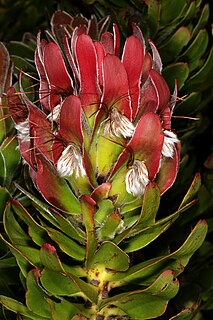
Mimetes fimbriifolius, also called cowl pagoda or the fringed pagoda, is a species of plant in the family Proteaceae. It is a dense, rounded, multi-branched tree that grows up to 4 metres in height. This attractive and striking plant flowers all year round, and produces red and yellow branch-heads and inflorescences. The nectar-rich flowers are pollinated by sunbirds and the seeds are distributed and taken underground by ants before germinating. It is endemic to the Table Mountain range in the city of Cape Town, South Africa.

Crassula capitella, is a perennial succulent plant native to southern Africa.

Crassula ovata, commonly known as jade plant, lucky plant, money plant or money tree, is a succulent plant with small pink or white flowers that is native to the KwaZulu-Natal and Eastern Cape provinces of South Africa, and Mozambique; it is common as a houseplant worldwide. Much of its popularity stems from the low levels of care needed; the jade plant requires little water and can survive in most indoor conditions. It is sometimes referred to as the money tree; however, Pachira aquatica also has this nickname.

Crassula nudicaulis is a succulent plant native to South Africa, and Lesotho.
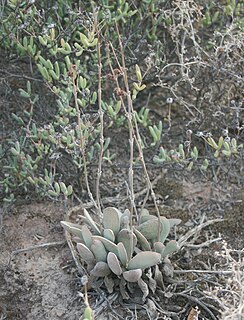
Crassula cotyledonis is a succulent plant endemic to the arid Namaqualand and Karoo regions of South Africa.

Felicia josephinae is a roughly hairy annual herbaceous plant of 15–20 cm (6–8 in) high, that is assigned to the daisy family. It branches near its base, and has few leaves along its stems. The lower leaves are set oppositely, inverted lance-shaped, relatively large at 3–7 cm long and ⅔–1¼ cm wide, and soon withering, while the higher ones are smaller and relatively narrower. In the axils of the leaves grow flower heads of 7–8 mm wide on stalks of up to 5 cm (2 in) long, topped with an involucre of about 5 mm (0.2 in) high and 4 mm (0.16 in) wide, consisting of eleven to thirteen bracts in two rows with bristles near the tip, eight to nine white or cream-coloured ligulate florets surrounding fourteen or fifteen deep purple disc florets. Flowers can be found in September and October. The species is an endemic species that can only be found in a small area along the west coast of the Western Cape province of South Africa.

Mimetes splendidus or splendid pagoda is an evergreen, rather sparsely branching, upright shrub of up to 2½ m (8 ft) high from the family Proteaceae. It has broadly lance-shaped to oval, silvery-hairy leaves with three or four teeth crowded at the tip. It has cylinder-shaped inflorescences that consists of many heads, each containing eleven to thirteen flowers, in the axils of the highest leaves. These leaves form a hood over a lower flowerhead and are flushed orangy pink. It flowers during winter, from early May to September. It is an endemic species that is restricted to the south face of the coastal mountains of the Western Cape province of South Africa.

Crassula brevifolia is a succulent plant native to the arid western edge of South Africa as well as southern Namibia.
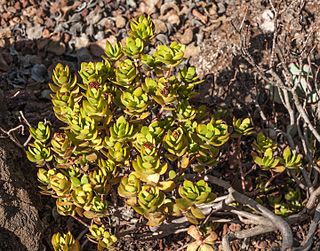
Crassula cultrata is a succulent plant native to the southern parts of South Africa.
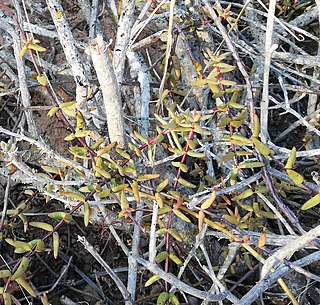
Crassula subaphylla is a succulent plant, widespread in the Karoo regions of South Africa and Namibia.
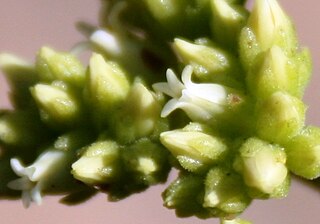
Crassula atropurpurea is a succulent plant, very common and widespread in the southern Karoo regions of South Africa and Namibia.
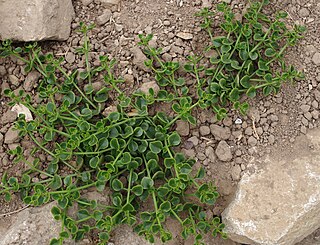
Crassula spathulata is a creeping, succulent ground-cover, indigenous to the Eastern Cape Province and southern KwaZulu-Natal, South Africa, where it is found in leaf-litter on rocky ridges, often around the edges of forests.

Crassula pellucida is a creeping, succulent ground-cover, or low-growing, spreading succulent shrub, indigenous to South Africa.
Senecio sarcoides is a species of succulent flowering plant in the aster family, indigenous to the Western Cape and Northern Cape, South Africa.

Protea angustata, also known as the Kleinmond sugarbush, is a flowering shrub that belongs to the genus Protea. This plant is endemic to the south-west Cape Region of South Africa.




















